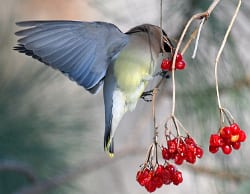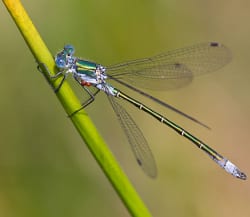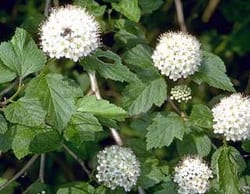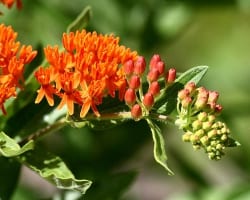Ellen Sousa, author of The Green Garden, is a garden coach who helps local gardeners build, maintain, and nurture safe, healthy, and beautiful landscapes. She writes and speaks about habitat gardening with an emphasis on native plants and recently answered some questions for ELA.
ELA: In the Preface to The Green Garden you promote the benefits of green gardening practices as one way individuals can take concrete action against widespread ecological disruptions due to climate change. How can small individual efforts make a difference in resolving such a huge problem?
Ellen Sousa: Scientists say we are well into the planet’s sixth major extinction of species, and we all know how that usually ends up for the dominating species. The acceleration of extinctions through habitat loss is something we can slow down while we still have the opportunity. Our governments may be twiddling their thumbs on climate change, but as the steward of even a tiny piece of land, we all have the opportunity to help slow down extinctions of many of the birds, insects, invertebrates, and other “little guys” that are struggling to hold our ecosystems together right now.

Even a small area of wildlife habitat can be part of a larger-scale system that supports a variety of birds, such as the Cedar Waxwing, and other species.
The diversity and range of species that can thrive in even a small area of wildlife habitat is staggering – and cumulatively across a community and region, individual habitats contribute to larger-scale habitat that supports even more species. This is an empowering feeling for a gardener who might be feeling very discouraged about the future of our species. Besides that, adopting greener lawn and gardening practices can reduce our carbon footprint in so many ways – just by composting home waste or finding a local farm/compost supplier, we avoid having to buy bagged chemicals produced in a faraway factory and trucked large distances to reach us. Contrary to what the large chemical company manufacturers would make us believe, chemicals are NOT required to maintain a green and lush lawn and garden. These are small things that add up in big ways.
ELA: You promote the use of native plants. What do you find is the best argument in favor of using native plants in the managed landscape?
ES: Even before I read Douglas Tallamy’s book Bringing Nature Home, I had observed that when I planted or encouraged regionally native plants on my own property, they seemed to attract more bird and insect activity than most of the exotic shrubs and trees we grew. I also noted over time that the more variety of insect species in an area, the fewer plant pest problems I had to worry about. The birds kept the caterpillar population mostly in check, and a wide variety of specialized parasitic and predatorial insects ensured that troublesome insects rarely got out of control. Further research by Tallamy since the publication of his book provides evidence of his hypothesis that native shrubs and trees attract substantially more diversity of insect species than non-native exotic plants.

Insects, including the Emerald Spreadwing dragonfly, play an integral role in a healthy environment. Photo by Christian Fischer
Even if most of us don’t like things flying or crawling around us, we need to learn to appreciate the integral role that insects play in a healthy environment, and understand that most of the bugs out there are not actually pests but either beneficial or benign. When we spray the pests, we also wipe out their predators. When it comes to insecticides, the pests will almost always make a comeback before the predators do, so instead of developing even more toxic sprays to control pests, we should concentrate on supplying more habitat for their natural controllers. So although there are many hardy non-native plants that are wildlife-friendly in some way, I encourage the planting of regional natives wherever possible as the simplest way to support the widest variety of the insects that in turn support the birds, bats, dragonflies, and the other animals that rely on a steady supply of insects as a food source. If we want to preserve our remaining biodiversity, we need to provide wildlife with what they need, because we ALL rely on the ecosystem services they provide.
From a landscaper’s point of view, because plants native to our area are already well adapted to the extremes of weather that we experience here in New England, it makes sense to grow them instead of exotic plants that originate from foreign soils and climates. It’s much easier to grow plants that naturally prefer your site conditions instead of trying to change the soil structure or keep an unhappy plant alive. And when grown in the right conditions, regionally native plants should thrive on our natural rainfall alone – no irrigation required.
ELA: Most of the US population lives in an urban or dense suburban setting. How can urban gardeners, or others with limited outdoor space, create habitat?
ES: There is so much you can do in a small space not only to attract interesting birds and butterflies, but also to supply your own household with healthy food that reduces the pesticide loads we carry from eating industrially-produced food. Container gardening is becoming huge. Every patio or deck, shady or sunny, can grow colorful plants that support the life cycles of small but beneficial wildlife such as pollinating insects. You can grow culinary herbs such as chives, cilantro, oregano, and thyme in a sunny spot for flavoring for cooking, and let some plants flower. The flowers will attract lots of interesting pollinating insects and their predators, including insect-eating birds.

Culinary herbs such as oregano grown in containers and left to bloom will attract pollinating insects and their predators. Photo by Christian Bauer
If you also supply water and nesting/hibernation opportunities for those tiny beneficial insects – something as simple as a bucket of moist soil and/or a tubular wooden “bee hotel” – you have a small habitat right there. Containers of nutritious salad greens can be grown in a partially shaded location even on a balcony. Leave a few to flower so the pollinators can work their magic, and you’ll have locally-adapted seeds that you won’t have to buy next year. And by growing some of what you consume yourself, you can reduce the energy and transportation required to bring food to your plate. And even if you don’t have much room to grow, you can also be a local habitat steward just by purchasing your seasonal produce from local farmers who manage their farmland in a sustainable way.
ELA: Is there one particular native plant that stands out as a “must have” for developing habitat? Or is there a plant that you always like to work into a design?
ES: I can’t possibly choose just one…but I can definitely say that flowering native (to New England) shrubs such as serviceberry, wild cherry, dogwood, New Jersey tea, native rose, and ninebark are gorgeous flowering shrubs that provide a LOT of resources for birds and insects – from nectar and pollen to berries or fruits, foliage for specialized herbivorous insects, plus good twiggy nesting opportunities for songbirds smack in the middle of a bountiful food source. A group of three of any of these shrubs = an instant wildlife thicket!
ELA: People often equate showy ornamental plants such as tulips and dahlias or Japanese maples with a desirable landscape. How would you advise landscape professionals to handle these client requests and attitudes?
ES: I do believe that people are beginning to understand that there are “good” and “bad” (i.e. harmful) ways of gardening and landscaping. I have been very lucky that most of my clients have accepted my advice to stop pouring chemical treatments into their lawns when I explain how bagged fertilizers contribute to dead soil and lake/bay eutrophication and how home garden pesticides can have negative health impacts on people (especially small children) and pets. Sometimes, it can be a hard sell to persuade a homeowner to remove invasive ornamental non-natives such as winged burning bush, Japanese barberry, Norway maple, Japanese honeysuckle, and purple loosestrife – but I am gratified that most of my clients understand that these exotic plants ultimately degrade wildlife habitat and biodiversity when they seed into natural areas and crowd out the native plants that the wildlife depend upon. I often hear from clients that once they removed the “xxx” invasive and replanted an area with natives, all kinds of new and interesting life began to make an appearance. So, when people are looking for new plants to add to their gardens, I will generally recommend regionally native plants that are appropriate to the site conditions, and I’ll talk to the client about why the plant is important to birds, butterflies, or whatever else might be living in the neighborhood. When people make that connection between a beautiful butterfly caterpillar and a specific plant or tree, they usually get very excited about it.
If a client has their heart absolutely set on a specific non-native plant, I will work it into a design only if it’s not a local invasive AND if I can’t find a suitable New England native with the same look and feel. For example, Schubert’s Red Chokecherry and several ninebark cultivars have that dark foliage that people crave and also produce beautiful flowers, unlike the Japanese maple. As for dahlias, if you love that big burst of summer color, garden phlox and native swamp/rose mallow provide the same enormous showy blooms and unlike the dahlias, you won’t have to dig them up and store them indoors for the winter! As native bloomers such as orange butterfly weed, running foamflower, wild rose, ninebark and sweet pepperbush have become more widely planted by landscapers because of their hardy nature and beautiful blooms, I believe people are beginning to notice that these plants are actually easier to grow than the tulips and dahlias and hybrid tea roses. Eventually, I believe mainstream garden trends will gravitate towards a less formal and more naturalistic style based on an understanding that a healthy, living soil nurtures plants and that plants grow best in conditions closest to their own natural habitat.
ELA: Organizations like National Wildlife Federation and Audubon have developed programs to encourage homeowners to share their yards with wildlife. Do you find these programs are raising awareness and increasing interest in landscapes that also provide habitat?
ES: Oh yes, especially when a sign is installed announcing that the yard or garden is a “habitat” of some kind. The MonarchWatch program, along with the NWF and Xerces Society can provide signs that are an excellent talking point for visitors to a garden. It’s a great way to make people think about the idea that a garden can be much more than something pretty to look at, that it can benefit the world outside in many ways.



